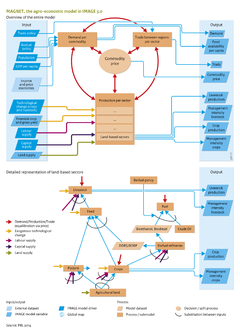Agricultural economy/Data uncertainties limitations
Parts of Agricultural economy/Data uncertainties limitations
| Component is implemented in: |
|
| Related IMAGE components |
| Projects/Applications |
| Key publications |
| References |
Data, uncertainty and limitations
Data
The MAGNET model most recently applied in conjunction with IMAGE uses the GTAP9 database for sectoral input–output tables and bilateral trade in the reference year 2011 (Aguiar et al., 2016). The model applies all GTAP sectors for agriculture but industrial and service sectors are aggregated into a few groups of sectors. The regional representation of GTAP is aggregated to match the IMAGE regions. For the start year, agricultural land use for both arable land and permanent grassland is based on FAO statistics. In addition, the model also uses a large number of essential coefficients, such as Armington trade elasticities, consumption function parameters, substitution elasticities for all production nests, CET elasticities for land-use transformations, and elasticities in the land supply curve. Some parameters are based on econometric research or economic literature, while others are no more than ‘best guesses’ (Woltjer et al., 2011). The autonomous technological yield change in is based on FAO projections in both MAGNET and IMAGE (Alexandratos and Bruinsma, 2012).
Uncertainties
Various model comparisons between different agro-economics have been carried out as part of the AgMIP project: for example, investigating the effects of variation in drivers between SSPs on key agro-economic variables such as crop area and food availability (Stehfest et al., 2019), the sensitivity of models for climate change impacts (Van Meijl et al., 2018) and a comparison of the effects on food security of yield changes due to climate change and climate change mitigation policies (Hasegawa et al., 2018).
Another model comparison within AgMIP included ten global agro-economic models using harmonized scenario drivers (Nelson et al., 2014; Von Lampe et al., 2014). In terms of future land-use expansion, MAGNET's results are in the upper range compared to other models. This is probably due to the relatively large land supply in MAGNET, which allows further expansion of agricultural land, particularly in North and South America, and Africa. In contrast, several other models do not explicitly consider agricultural land expansion, but only allow interchanges between, for example, arable land and grassland. In addition to land supply, the most relevant uncertainties in MAGNET are autonomous technological change, relative contribution of intensification or expansion to total production growth, retaining current trade patterns in long-term scenarios, and dynamics in the livestock sector, especially with respect to pasture area and grassland intensification (Stehfest et al., 2013), and long-term dietary preferences. The empirical basis for many of these parameters in MAGNET and all other agro-economic models needs to be improved (Hertel, 2011).
Limitations
The MAGNET model provides a complete and internally consistent view of the world economy, covering all economic sectors, and a dynamic modelling of all primary and intermediate production and demand. However, a little known limitation is the uncertainties in constructing the GTAP/MAGNET database because many ad hoc assumptions need to be made to fill the database, for instance, allocating value added across inputs.
Furthermore, volumes in the model are not expressed in physical terms but in monetary values. Likewise, all substitutions in the model are based on monetary values. As a consequence, there is no guarantee that changes in composition are consistent with the physical requirements, such as in livestock feed. Thus, a closer link to physical units is needed (Woltjer, 2011).
Because of the highly aggregated and general character of MAGNET, most elasticities are kept constant over time. Some improvements have been introduced in the consumption function, by making the income elasticities dependent on income levels. Armington elasticities are also constant, and thus small trade flows in the starting year only increase very slowly in future years.
Although some limitations can be reduced by adding physical units and improving the empirical basis for the main elasticities, many simplifications in agro-economic models will remain. MAGNET provides a consistent system to assess economy-wide effects of policy measures on land use, income, welfare and production, and supports policymakers and scientists in gaining insights into the complex interlinkages in the agricultural system. Nevertheless, simplifications and uncertainties that result from such a broad coverage need to be kept in mind when interpreting results.
